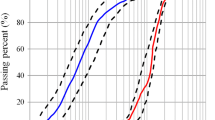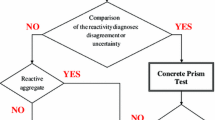Abstract
The deleterious phenomenon in concrete due to alkali–silica reactivity of an aggregate can be evaluated by an accelerated mortar bar test. This study investigates the individual and combined effect of solution concentration, cement alkali and test duration on expansion, and proposes expansion models consisted of the above-mentioned three parameters. The specimens of this study were prepared from six aggregates having different mineralogy, and three dosages of cement alkalis of 0.42, 0.84 and 1.26 % Na2Oeq. They were submerged in three concentrations (1.0, 0.5 and 0.25 N) of NaOH solution, and were tested at 14, 28, 56 and 98 days. The results showed that the major contributions to expansion were due to solution concentration, followed by test duration and cement alkali.







Similar content being viewed by others
References
Stanton TE (1940) Expansion of concrete through reaction between cement and aggregate. Proc Am Soc Civ Eng 66(10):1781–1811
Swamy RN (1992) The alkali–silica reaction in concrete. Blackie and Son Ltd., Glasgow
HAFÇI A (2013) Effect of alkali–silica reaction expansion on mechanical properties of concrete. Master’s Thesis, Middle East Technical University. http://etd.lib.metu.edu.tr/upload/12616369/index.pdf
Islam MS, Akhtar S (2013) A critical assessment to the performance of alkali–silica reaction (ASR) in concrete. Canad Chem Trans 2(4):253–266
Islam MS, Ghafoori N (2014) Relation of ASR-induced expansion and compressive strength of concrete. Mater Struct. doi:10.1617/s11527-014-0465-6
Kagimoto H, Yasuda Y, Kawamura M (2014) ASR expansion, expansive pressure and cracking in concrete prisms under various degrees of restraint. Cem Concr Res 59:1–15
Leśnicki KJ, Kim JY, Kurtis KE, Jacobs LJ (2013) Assessment of alkali–silica reaction damage through quantification of concrete nonlinearity. Mater Struct 46(3):497–509
Pignatelli R, Comi C, Monteiro PJ (2013) A coupled mechanical and chemical damage model for concrete affected by alkali–silica reaction. Cem Concr Res 53:196–210
Folliard KJ, Thomas MDA, Fournier B, Kurtis KE, Ideker JH (2006) Interim recommendations for the use of lithium to mitigate or prevent alkali–silica reaction (ASR). Report No. FHWA-HRT-06-073, Federal Highway Administration, McLean
Fernandes I, Broekmans MA (2013) Alkali–silica reactions: an overview. Part I. Metallogr Microstruct Anal 2(4):257–267
Çopuroğlu O, Andiç-Çakir Ö, Broekmans MA, Kühnel R (2009) Mineralogy, geochemistry and expansion testing of an alkali-reactive basalt from western Anatolia, Turkey. Mater Charact 60(7):756–766
Yuksel C, Ahari RS, Ahari BA, Ramyar K (2013) Evaluation of three test methods for determining the alkali–silica reactivity of glass aggregate. Cem Concr Compos 38:57–64
Mindess S, Young JF, Darwin A (2002) Concrete, 2nd edn. Pearson Education Ltd., Delhi
ACI Committee 221 (1998) State-of-the-art report on alkali–aggregate reactivity. ACI Manual of Concrete Practice Part 1, American Concrete Institute, Farmington Hills
Islam MS (2010) Performance of Nevada’s aggregates in alkali–aggregate reactivity of Portland cement concrete. PhD thesis, University of Nevada Las Vegas
Islam MS, Ghafoori N (2013) Evaluation of alkali–silica reactivity using aggregate geology, mortar bars, concrete prisms and ASR kinetic model. J Mater Sci Res 2(2):103–117
ASTM (American Society for Testing and Materials) Standard C1260 (2007) Standard test method for potential alkali reactivity of aggregates (mortar-bar method). ASTM International, West Conshohocken
Golmakani F (2013) Possible modifications to the accelerated mortar bar test (ASTM C1260). Master’s Thesis, University of Toronto
Touma WE, Fowler DF, Carrasquillo RL (2001) Alkali–silica reaction in Portland cement concrete testing methods and mitigation alternatives. International Center for Aggregates Research, ICAR 301-1F
Islam MS (2015) Prediction of ultimate expansion of ASTM C 1260 for various alkali solutions using the proposed decay model. Constr Build Mater 77:317–326
Ghafoori N, Islam MS (2013) Time series analysis for prediction of ASR-induced expansions. Constr Build Mater 49:194–200
Touma WE, Fowler DW, Carrasquillo RL, Folliard KJ, Nelson N (2002) Characterizing alkali–silica reactivity of aggregates using ASTM C 1293, ASTM C 1260, and their modifications. Transp Res Rec 1757:157–165
Shon CS, Zollinger DG, Sarkar SL (2002) Evaluation of modified ASTM C 1260 accelerated mortar bar test for alkali–silica reactivity. Cem Concr Res 32:1981–1987
Shon CS, Sarkar SL, Zollinger DG (2004) Testing the effectiveness of Class C and Class F fly ash in controlling expansion due to alkali–silica reaction using modified ASTM C 1260 test method. J Mater Civ Eng 16(1):20–27
Multon S, Sellier A, Cyr M (2009) Chemo-mechanical modeling for prediction of alkali silica reaction (ASR) expansion. Cem Concr Res 39(6):490–500
Gao XX, Multon S, Cyr M, Sellier A (2013) Alkali–silica reaction (ASR) expansion: pessimum effect versus scale effect. Cem Concr Res 44:25–33
Du H, Tan KH (2014) Effect of particle size on alkali–silica reaction in recycled glass mortars. Constr Build Mater 66:275–285
Ramyar K, Topal A, Andiç Ö (2005) Effects of aggregate size and angularity on alkali–silica reaction. Cem Concr Res 35(11):2165–2169
Hooton RD, Rogers CA (1993) Development of the NBRI rapid mortar bar test leading to its use in North America. Constr Build Mater 7(3):145–148
Van Aardt JHP, Visser S (1982) Reactions between rocks and the hydroxides of calcium, sodium and potassium. Progress Report Part 2, CSIR Research Report BRR 577, Pretoria
Hooton RD (1995) Test procedures for ASR. In: Proceedings of the third annual ICAR symposium, concrete, bases, and fines, Center for Aggregates Research (ICAR), Austin. http://aftre.nssga.org/Symposium/1995-31.pdf
Mather B (1999) How to make concrete that will not suffer deleterious alkali–silica reaction. Cem Concr Res 29:1277–1280
Ferraris CF (1995) Alkali–silica reaction and high performance concrete. National Institute of Standards and Technology, Report No. NISTIR 5742
Kerenidis K (2007) Mitigating alkali–silica reaction in concrete with supplementary cementing materials when used in conjunction with Portland cements having alkali contents in excess. Master’s thesis, University of Toronto
Poole AB (1992) Introduction to alkali–aggregate reaction in concrete. In: Swamy RN (ed) The alkali–silica reaction in concrete. Blackie and Son, London
Bérubé MDA, Frenette J (1994) Testing concrete for AAR in NaOH and NaCl solutions at 38 °C and 80 °C. Cem Concr Compos 16(3):189–198
Diamond S (1983) Alkali-reactions in concrete-pore solution effects. In: Proceedings of the sixth international conference on alkalis in concrete, pp 155–166
Oberholster RE, Davies G (1986) An accelerated method for testing the potential alkali reactivity of siliceous aggregates. Cem Concr Res 16:181–189
Kuroda T, Inoue S, Yoshino A (2000) ASR expansion characteristics of mortar bars immersed in NaOH solution by autoclave method. In: Proceedings of the 11th international conference on alkali–aggregate reaction, pp 375-384
Ghanem H, Zollinger D, Lytton R, Ghanem N (2012) Determining ASR characteristics using dilatometer method. Constr Build Mater 36:1008–1015
Lindgård J, Andiç-Çakır Ö, Fernandes I, Rønning TF, Thomas MD (2012) Alkali–silica reactions (ASR): literature review on parameters influencing laboratory performance testing. Cem Concr Res 42(2):223–243
Tuthill L (1982) Alkali–silica reaction: 40 years later. Concr Int 4:32–36
Bérubé MA, Fournier B (1993) Canadian experience with testing for alkali–aggregate reactivity in Concrete. Cem Concr Compos 15:27–47
Thomas MDA, Fournier B, Folliard J, Ideker J, Resendez Y (2007) The use of lithium to prevent or mitigate alkali–silica reaction in concrete pavements and structures. U.S. Department of Transportation, Publication No. FHWA-HRT-06-133
Ikeda T, Kawabata Y, Hamada H, Sagawa Y (2008). Alkali–silica reactivity of andesite in NaCl saturated solution. In: Proceedings of the international conference on durability of concrete structures, pp 563–569
Islam MS, Ghafoori N (2013) Evaluation of alkali–silica reactivity using ASR kinetic model. Constr Build Mater 45(270):274
Lane DS (1994) Alkali–silica reactivity in Virginia. Virginia Transportation Research Council. Final Report No. VTRC 94-R17, Virginia Transportation Research Council, Charlottesville
Korkanç M, Tuğrul A (2005) Evaluation of selected basalts from the point of alkali–silica reactivity. Cem Concr Res 3(3):505–512
Islam MS (2014) Comparison of ASR mitigation methodologies. Int J Concr Struct Mater 8(4):315–326
Stark D, Morgan B, Okamoto P, Diamond S (1993) Eliminating or minimizing alkali–silica reactivity. Strategic Highway Research Program, SHRP-P-343, Washington, DC
Heck WJ (1983) Study of alkali–silica reactivity tests to improve correlation and predictability for aggregates. Cem Concr Aggreg. doi:10.1520/CCA10251J
CSA (Canadian Standards Association) (2000) Guide to the evaluation and management of concrete structures affected by alkali–aggregate reactions. CSA International, Toronto
Deng M, Han SF, Lu YN, Lan XH, Hu YL, Tang MS (1993) Deterioration of concrete structures due to alkali–dolomite reaction in China. Cem Concr Res 23:1040–1046
Li BX, Zhang JF, Ke D (2011) Effectiveness and mechanism of fly ash in inhibiting alkali–silica reaction of sandstone. Period Adv Mater Res 250–253:40–45
Acknowledgments
The authors would like to acknowledge Nevada Department of Transportation, aggregate and cement producers for supplying materials. The financial supports of Nevada Department of Transportation and Natural Sciences and Engineering Research Council of Canada are also gratefully acknowledged.
Author information
Authors and Affiliations
Corresponding author
Rights and permissions
About this article
Cite this article
Islam, M.S., Alam, M.S., Ghafoori, N. et al. Role of solution concentration, cement alkali and test duration on expansion of accelerated mortar bar test (AMBT). Mater Struct 49, 1955–1965 (2016). https://doi.org/10.1617/s11527-015-0626-2
Received:
Accepted:
Published:
Issue Date:
DOI: https://doi.org/10.1617/s11527-015-0626-2




